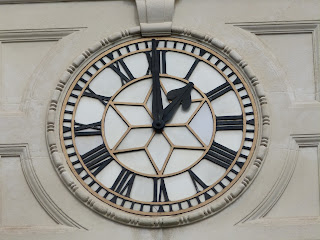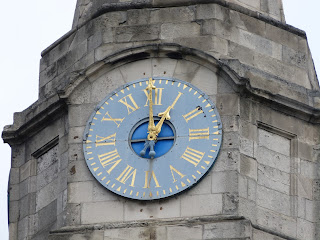This weekend has been the annual Open House London time, with 750 buildings open to the public.
As usual, a big thanks goes to the overall organisers (see www.openhouselondon.org.uk), all the building owners, the staff and the volunteers for making this such a great event.
This is my record of the clocks that I saw at or from the buildings I visited.
Also, I thought that I knew the City of London pretty well in terms of its clocks, but on my wanderings between buildings I spotted five clocks which I hadn't previously recorded. These will be shown in later postings - in fact I feel that the time has come to have a post for every single public clock in the City of London, so watch this space. And judging by this weekend's experience, I will need your help in finding the ones that I don't know about. Any guesses yet for how many clocks there are in the City?
My buildings this year were St Paul's, St Lawrence Jewry, a talk at the Guildhall City Centre, St George's Bloomsbury, St Botolph's Building, Holland House, St Botolph's church, Bevis Marks Synagogue and Drapers Hall.
So, we start with St Paul's Cathedral. I don't I need to say anything about the building, but here is its clock:
St Lawrence Jewry sits by the Guildhall, and is a 17th century building by Sir Christopher Wren (and hence linked to St Paul's) - although the interior is a more modern refurbishment following extensive damage in World War II.
And thank you to the volunteer who informed me that the ornate gilded ironwork in front of the Lord Mayor's pew was of course a sword rest.
Taking an excursion outside of the City, my next stop is St George's Bloomsbury in Bloomsbury Way.
This is one of Nicholas Hawksmoor's 18th century masterpieces.
And in typical Hawksmoor style is fantastically bonkers. The tower has a steeple based on the design of the Mausoleum of Halicarnassus, topped with a statue of George I...
...and a lion and a unicorn thrown in for good measure.
The St Botolph Building is at 138 Houndsditch (always great road names in the City), and is a 52,000 square metre floorspace office building completed in 2010.
No clocks on this building, but you can spot a few out of the windows of the thirteenth floor:
Christchurch, Spitalfields (another Hawksmoor theatrical creation)-
St Botolph, Bishopgate -
and Liverpool Street station -
And all credit to Clyde & Co LLP for opening up their office floor, and for displaying a collection of artwork from students from London arts colleges (www.artawards.clydeco.com).
The colour of the building was supposedly chosen to match the centre of the clock on nearby St Botolph Aldgate:
St Botolph Aldgate is by George Dance the Elder, and dates from the 1740s.
Next up is another place of worship, Bevis Marks Synagogue, dating from 1701 and the oldest synagogue in Britain.
And finally on to Drapers Hall in Throgmorton Street. This is one of the City's livery halls, and originally dates back to the 1530s, although with subsequent rebuilding. The magnificent interior is mostly Victorian.
This is the Livery Hall...
...with a clock on the right hand side of the end wall..
..and a wind direction gauge on the left hand side.
The Drawing Room has this clock in the fireplace:
I now wait for Open House London 2017.



























































